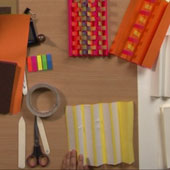One of the earliest known books are the clay tablets of the Babylonian sand Assyrians. They were written in cuneiform—wedge-shaped characters—on the clay. They were often stored in clay “envelopes” that protected the tablets much as a modern library book cover does today. Even then, there were libraries full of clay books. The Royal Library of Ninevah—capital of the ancient empire of the Assyrians—contained thousands of clay books on every subject from astronomy to recipes to love poems to legends.
The papyrus scroll was made by ancient Egyptians from the aquatic, reed-like plant Cyperuspapy-rus, that grew along the banks of the Nile river. The stems were cut into thin strips and laid next to each other, one slightly overlapping the next. Another layer was placed on top, perpendicular to the first. These were lightly pounded to bind them together. Since the sheets were small, several were glued together end-to-end to form a scroll. The scroll was then wound around a wooden stick. The Egyptians wrote their hieroglyphics with a length of reed cut into a pen. One of the oldest papyrus scrolls dates from 2500 BC.
The Romans used wax tablets. These books were made of pieces of wood with a slight hollow carver in them to hold a layer of blackened wax. They wrote by making indentations with an iron stylus (similar to our pencil) and erased by rubbing out the words with the flattened end of the stylus or their finger. Mainly used for business transaction, several of them could be strung together to make something similar to our three-ring binders. Children also used them for their school lessons.
Another interesting form is the leaf book. Palm leaves were trimmed to size and the letters were cut into the leaf. Charcoal was rubber onto he letters to darken their outlines and several leaves were strung together to make a book.
Between the 5th and 11th centuries the decoration of books was mostly done with precious jewels, carved ivory and gold. The Copts of Alexandria, Egypt decorated their leather bindings with lines and dots made with metal punches. In the 12th century, leather tooling became very popular in England. Designs and ornamentation were stamped into the leather.
In the 15th century gold tooling was introduced by Italian and French craftsmen working under the influences of the Arabs of Morocco. Think pieces of gold were laid on the leather with some adhesive and the design was pressed into the leather. In the 16th century embroidered fabric became popular and Queen Elizabeth I is said to have embroidered cloth for book covers. Silks, velvet, seed pearls, silver and gold thread were all used to make the beautiful covers.
With the invention of the printing press, movable type and the introduction of paper to the West, the nature of bookbinding changes. More books were produced and the binder had to find new, faster methods to bind and decorate them. In 1861 David Smyth invented a book sewing machine.

